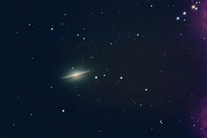m104sombrero_1600iso_300sec_f065_11_dd.jpg
m104sombrero_1600iso_300sec_f065_11_dd.jpg
(m104sombrero_1600iso_300sec_f065_11_dd.jpg)
304mm f/10.0 lx200gps 12" scope at f/6.5 with taurus tracker III focal reducer, canon 300d camera at 1600iso. Single 5min exposure. Taken at Hildebrandt Ranch.
Messier 104
Spiral Galaxy M104 (NGC 4594), type Sa, in Virgo
Sombrero Galaxy
Right Ascension 12 : 40.0 (h:m)
Declination -11 : 37 (deg:m)
Distance 50000 (kly)
Visual Brightness 8.0 (mag)
Apparent Dimension 9x4 (arc min)
Discovered by Pierre Méchain in 1781.
Excerpt from seds.org:
Messier 104 (M104, NGC 4594) is numerically the first object of the catalog which was not included in Messier's originally published catalog. However, Charles Messier added it by hand to his personal copy on May 11, 1781, and described it as a "very faint nebula." It was Camille Flammarion who found that its position coincided with Herschel's H I.43, which is the Sombrero Galaxy (NGC 4594), and added it to the official Messier list in 1921. This object is also mentioned by Pierre Méchain as his discovery in his letter of May 6, 1783. William Herschel found this object independently on May 9, 1784.
This brilliant galaxy was named the Sombrero Galaxy because of its appearance. According to de Vaucouleurs, we view it from just 6 degrees south of its equatorial plane, which is outlined by a rather thick dark rim of obscuring dust. This dust lane was probably the first discovered, by William Herschel in his great reflector.
This galaxy is of type Sa-Sb, with both a big bright core, and as one can see in shorter exposures, also well-defined spiral arms. It also has an unusually pronounced bulge with an extended and richly populated globular cluster system - several hundred can be counted in long exposures from big telescopes.
Recent very deep photographs from the Anglo-Australian Observatory show that this galaxy has a very extended faint halo.
This galaxy was the first one with a large redshift found, by Vesto M. Slipher at Lowell Observatory in 1912. Its redshift corresponds to a recession velocity of about 1,000 km/sec (it is caused by the Hubble effect, i.e. the cosmic expansion). This was too fast for the Sombrero to be an object in our Milky Way galaxy. Slipher also detected the galaxy's (then the nebula's) rotation.
M104 is the dominating member of a small group of galaxies, the M104 group or NGC 4594 group of galaxies.
